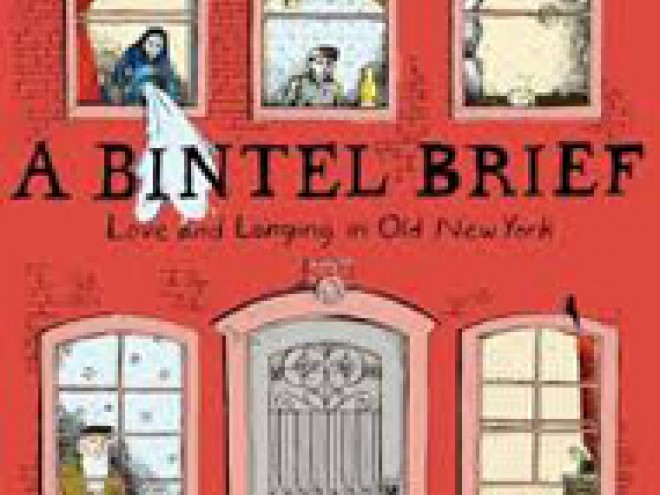Earlier this week, Liana Finck shared the history behind the Forward’s Bintel Brief column. Her graphic novel, A Bintel Brief, was published by Ecco. She will be blogging here all week for Jewish Book Council and MyJewishLearning.
 I did not mean to fall in love with the Bintel Brief letters. I grew up Jewish in the New York suburbs and defined myself by what the Jewish suburbs were not — I was an odd, shy kid who loved animals and nature and who drew, and I felt like an alien among the mall rats. (At least, that is how I remember things.) I escaped as soon as I could, to art college in New York, in search of ‘my people’ — artists and writers — and art, and books. I knew before I graduated that I wanted to make graphic novels, but it didn’t matter to me what story I told. The medium was the message. After college, I went to Belgium on a Fulbright grant. I had wanted to get away from everyone I knew; I still felt more comfortable with art and books than with people. I sensed that the sooner I made a book of my own, the sooner I would feel that I had a reason to exist; and I believed that the fastest way to create that book would be in a kind of social vacuum. But I sunk under the weight of the graphic novel I was trying to work on (which was to be about a comics artist’s tortured friendship with a fine artist); I was frustrated by what I later realized was a lack of fluency in the craft of comics-making. Mid-way into my year abroad, my grandmother sent me the first half of Isaak Metzker’s two-volume collection of Bintel Brief letters translated into English—A Bintel Brief: Sixty Years of Letters from the Lower East Side to the Jewish Daily Forward (Doubleday, 1971).
I did not mean to fall in love with the Bintel Brief letters. I grew up Jewish in the New York suburbs and defined myself by what the Jewish suburbs were not — I was an odd, shy kid who loved animals and nature and who drew, and I felt like an alien among the mall rats. (At least, that is how I remember things.) I escaped as soon as I could, to art college in New York, in search of ‘my people’ — artists and writers — and art, and books. I knew before I graduated that I wanted to make graphic novels, but it didn’t matter to me what story I told. The medium was the message. After college, I went to Belgium on a Fulbright grant. I had wanted to get away from everyone I knew; I still felt more comfortable with art and books than with people. I sensed that the sooner I made a book of my own, the sooner I would feel that I had a reason to exist; and I believed that the fastest way to create that book would be in a kind of social vacuum. But I sunk under the weight of the graphic novel I was trying to work on (which was to be about a comics artist’s tortured friendship with a fine artist); I was frustrated by what I later realized was a lack of fluency in the craft of comics-making. Mid-way into my year abroad, my grandmother sent me the first half of Isaak Metzker’s two-volume collection of Bintel Brief letters translated into English—A Bintel Brief: Sixty Years of Letters from the Lower East Side to the Jewish Daily Forward (Doubleday, 1971).

Reading the collection of Bintel Brief letters was the most urgent thing that happened to me that year. I hadn’t brought any English books to Brussels because I wanted to force myself to learn French; so the book was rare and precious, like a relic from my lost civilization. When I started reading, the letters reminded me why I wanted to make a book in the first place. They made me cry. I also began to relate to the letter-writers — who had left home in search of a new life, and landed in New York. Then, with a shock, I realized that the letter-writers could have been my great-grandparents. I’d set out on a journey looking for a treasure, only to find it buried deep down under my own doorstep. When I got home from Belgium, I chose some of the Bintel Brief letters from Metzker’s book — and some other, untranslated letters from microfilm copies of The Forward—and began adapting them into a graphic novel. I still wrestled with my medium, but less. It was easier because I had a story to tell.
Liana Finck is an emerging graphic novelist. She was a Fulbright Fellow in Brussels in 2009-10 and is a Six Points Fellow in New York. She publishes in The Forward Newspaper and Tablet Magazine. Read more about her here.
Related Content:
- A Living Lens: Photographs of Jewish Life from the Pages of The Forward by Alana Newhouse
- Will Eisner’s New York: Life in the Big City by Will Eisner
- Hand-Drying in America: And Other Stories by Ben Katchor
- Unterzakhn by Leela Corman
- Essays: The Back Story, Inspiration, and Family Ties
Liana Finck is the author of Passing for Human and Excuse Me and a regular contributor to The New Yorker. She is a recipient of a Fulbright Fellowship, a New York Foundation for the Arts Fellowship, and a Six Points Fellowship for Emerging Jewish Artists. She has had artist residencies with MacDowell, Yaddo, the Lower Manhattan Cultural Council, Headlands Center for the Arts, and Willapa Bay.



